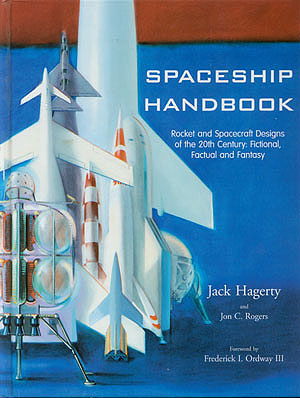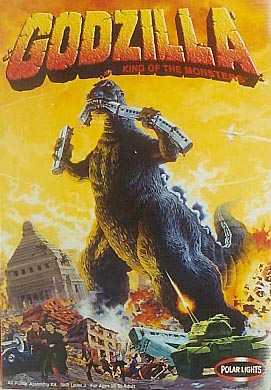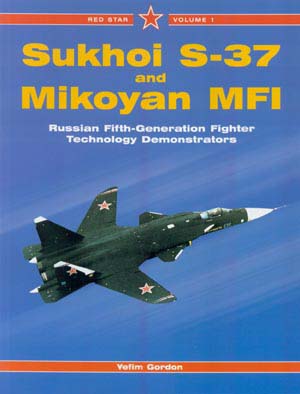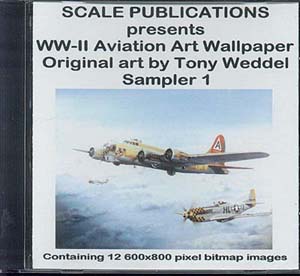| Richard Marmo's SCALEWORLD |
Well, despite the best efforts of doctors and prescription drugs, I'm back. If that statement sounds strange, it's not. There was a nasty little respiratory infection running around the area (maybe the country) that just about everyone was catching. To combat it, my doctor prescribed Avelox…which just happens to be a very new synthetic antibiotic. By the time I'd had two doses of it, I was headed for the ER with an allergic reaction. It took five days to leech all the side effects out of my system. What's really interesting is the fact that the chemical base for Avelox is the same as Cipro! Oh, well, that's enough news from the medical front. Back to modelbuilding.
It used to be that reference publications for the various subjects we build were few and far between. No longer. It seems like every time you turn around, another eight or ten books have been announced. We all talk about this being the golden age of model building, but it's also the golden age for references. For example:
 ARA PRESS (https://www.arapress.com) has published an incredible hardback book that is an absolute must for the spacecraft enthusiast. This holds true whether your interest is science fiction or the real thing. Titled SPACESHIP HANDBOOK, Rocket And Spacecraft Designs of the 20th Century: Fictional, Factual and Fantasy, and written by Jack Hagerty & Jon C. Rogers, it runs 540 pages in length and sells for $59.95 plus $5.00 s&h ($10.00 Priority).
ARA PRESS (https://www.arapress.com) has published an incredible hardback book that is an absolute must for the spacecraft enthusiast. This holds true whether your interest is science fiction or the real thing. Titled SPACESHIP HANDBOOK, Rocket And Spacecraft Designs of the 20th Century: Fictional, Factual and Fantasy, and written by Jack Hagerty & Jon C. Rogers, it runs 540 pages in length and sells for $59.95 plus $5.00 s&h ($10.00 Priority).
Crammed inside its 9" x 11 1/4" hard covers is more material than any book of this type has any right to contain. Before you even get to the contents, you find an insert promoting NARCON 2002 (National Association of Rocketry Convention) that takes place April 5-7 in Austin, Texas. You'll also find a blue 8 1/2" x 11" feedback page that asks two questions; Where'd We Goof? and What'd We Miss. The Goofs section is so they can correct those inevitable errors that escape the proofreading, even on the fifth time around. As for the Miss? category, let ARA know what else you would have liked to have seen in this volume. They had to cut a lot of material to keep it this small (?), so there may well be a second volume. That's if enough of you buy this volume.
Now to the contents. Once you get past the copyright notices, dedication, how to use the book and acknowledgements (three pages worth), you'll find that it's actually divided into three parts; The Theoreticians, The Entertainers and The Real Stuff. And each part is divided into multiple sections.
The Theoretician section will have the rocket/spacecraft enthusiast salivating from start to finish, faced with the delightful problem of which rocket or design do you try to model first. Tsiolkovsky and Oberth had some very unique and innovative ideas and then there was Sanger with his hypersonic, rocket-powered skip bomber known as the Silver Bird.
From here we move into an area that's like a homecoming for those of us who grew up and were deeply influenced by the various Willy Ley/Werner von Braun spacecraft designs. The combination of Ley's designs and Chesley Bonestell's incredible photo-realistic space illustrations fired the imagination of an entire generation. But Ley/Bonestell weren't alone. Werner von Braun's spacecraft designs wound up in many different mass media publications including Collier's, This Week and a series of films produced by Walt Disney (remember the wheeled space station by Strombecker?).
The Entertainers is exactly what the name implies. Fictional spacecraft that most of us are familiar with through science fiction novels, comic strips and TV shows. The Buck Rogers Spider Ship for example. Rocketship X-M, Rocketship M-1, the immense variety of designs from the various George Pal productions (including a magnificent 2-page spread of drawings of the Space Ark from When Worlds Collide), the Starship Vittoria from Starship Through Space and on and on. Gerry Anderson's Thunderbirds designs, the 2001:A Space Odyssey ships, even the spaceship from Josie & The Pussycats in Outer Space cartoon.
Finally we get to The Real Stuff. You'll find 10 pages devoted to the Dyna-Soar X-20, another 9 on the NOVA heavy lifter. Then there's the insane weapon called Project Pluto. This thing was a delivery system for multiple nuclear warheads that was launched vertically with strap-on boosters. Once the boosters were expended, power was provided by an unshielded nuclear reactor that would drive the beast at Mach 3 for 10 hours (and could have been extended to two weeks). There are sufficient drawings to build a model of this creature if you so desire. If you're looking for something different, this is it.
Other sections cover the Manned Orbital Laboratory and the various RLV (Reusable Launch Vehicle) designs as they existed on December 31, 1999.
The book is loaded with large, clear, dimensioned drawings of the various spacecraft described. Believe me, any modelbuilder worth his salt…and an interest in spacecraft/science fiction/fantasy… could spend the next several years in this book without coming up for air.
Believe it or not, we're not done yet. You'll also find a 51 page Appendix discussing the concept of the Atomic Powered Spaceship. Another Appendix (B) runs to 22 pages and will grab the attention of anyone interested in building and flying model rockets. Included are plans for the Luna from Destination Moon, two different Thunderbirds ships and an X-20/Titan IIIE. Finally, there's a 16 page index.
Despite all the preceeding verbage, I haven't come close to doing this book justice. The bottom line is this: If you have more than a passing interest in the subject of spacecraft, real or imagined, then you owe it to yourself to scrounge up $60 and buy a copy.
In 1954, a monster movie called Gojira appeared in Japan that was essentially a warning against atomic weapons testing. Two years later, in 1956, it was reshot, Raymond Burr was added to the cast and the film's name became Godzilla. The rest, as they say, is history. As a matter of fact, an indication of the beast's popularity can be found in the 24 different Godzilla films that have been produced since.
 The modeler, of course, has been left wanting. Aurora produced a small kit of Godzilla as part of their monster line, which was later repopped by POLAR LIGHTS. But we had to wait for the arrival of an all new, original sculpt Godzilla from POLAR LIGHTS (https://www.polarlights.com) to get our hands on a really imposing creature. It was worth the wait.
The modeler, of course, has been left wanting. Aurora produced a small kit of Godzilla as part of their monster line, which was later repopped by POLAR LIGHTS. But we had to wait for the arrival of an all new, original sculpt Godzilla from POLAR LIGHTS (https://www.polarlights.com) to get our hands on a really imposing creature. It was worth the wait.
Packed in a sturdy 11 1/2" x 16 1/2" x 6 1/2" fliptop box, the kit contains 76 parts in a bright green styrene. By the way, there's a little window on the side of the box that allows you to see the color of the parts. Why? Because every 12th kit is molded in white instead of green and the window allows the collector/investor to identify those rarer kits.
Anyway, parts are crisply molded with good detail. Instructions follow the usual retro style that POLAR LIGHTS enthusiasts are familiar with. Designed as a diorama, parts include a substantial base (it'd have to be since the critter's 16" tall) that contains portions of several destroyed buildings and a tank that's firing at the beast. You also have two railroad cars, one being gripped in Godzilla's left claws. The other one's in his mouth, about to take on the role of an after dinner mint.
For those who are so taken with the front box art that they want to create a model that duplicates it exactly, the side and back of the box can be cut out and positioned both in front and behind the completed model.
Construction will quite straightforward, but there are a couple of points that need to be discussed. Various websites and bulletin boards have carried complaints about the detail in the joints being 'soft' and the head being too small, along with the claws. Others argue that there aren't enough fins that run down the spine. I've even heard one person state that the railroad car in Godzilla's mouth doesn't look like a Japanese-style train. In other words, they're saying the kit's wrong. Well, maybe so, maybe no.
The reason for that statement is this: When Godzilla was filmed, the creature was antimated by a guy in a monster suit stomping his way thru scale models of the various city sections. This leads to two problems that go hand in glove. First, scenes aren't filmed sequentially and secondly, there was more than one suit. There were actually two full-size suits and a smaller scale 3-dimensional model of the creature. Since the film wasn't being made with the model builder in mind (you thought it was?) and it was obviously low-budget, you can be sure that the two full-size suits and the smaller model weren't identical to each other. The problem still exists today on virtually any special-effects laden film you care to mention.
At any rate, the sculptor apparently used the miniature as his information source. All this means is that, if you want your Godzilla to exactly match a particular scene in the film, you'll have to do a little conversion work. But isn't that what model building's about? As for the 'soft' detail in the joints, that's a technical problem. Not only is styrene not flexible, the parts are created with metal molds which means that you can't get away with severe undercuts and high relief detail like you can on resin and vinyl. Again, a little putty and modelmaking skills solve that problem rather easily.
What it all boils down to is the fact that, for $24.99, we now have a large, imposing Godzilla that looks good straight out of the box. Spend some time utilizing conversion and detailing skills and it can be truly spectacular. What more could you ask for?
 Anyone who has an interest in Soviet (or Russian) aircraft, particularly the newest ones, aren't going to be able to resist Volume 1 of a new Red Star series from MIDLAND PUBLISHING. Distributed in North America by SPECIALTY PRESS (https://www.specialtypress.com) , this first volume, Sukhoi S-37 and Mikoyan MF1 by Yefim Gordon covers a pair of Russian Fifth-Generation Fighter Technology Demonstrators that I suspect many of us didn't even know existed. The most fascinating of the pair, and the subject of the cover photo, is the S-37. This one many of us will be familiar with (or will at least remember seeing a photo) because of it's innate strangeness. Solid black (in order to hide certain design details) with twin engines, swept forward wings, twin tails and small canard foreplanes, seeing it once is to remember it forever.
Anyone who has an interest in Soviet (or Russian) aircraft, particularly the newest ones, aren't going to be able to resist Volume 1 of a new Red Star series from MIDLAND PUBLISHING. Distributed in North America by SPECIALTY PRESS (https://www.specialtypress.com) , this first volume, Sukhoi S-37 and Mikoyan MF1 by Yefim Gordon covers a pair of Russian Fifth-Generation Fighter Technology Demonstrators that I suspect many of us didn't even know existed. The most fascinating of the pair, and the subject of the cover photo, is the S-37. This one many of us will be familiar with (or will at least remember seeing a photo) because of it's innate strangeness. Solid black (in order to hide certain design details) with twin engines, swept forward wings, twin tails and small canard foreplanes, seeing it once is to remember it forever.
Produced in an 8 1/2" x 11" format, it's very similar, but not identical, to the reformatted Warbird Tech Series from SPECIALTY PRESS. Bound between heavyweight semi-stiff covers, you get 128 pages of slick stock with some 180 photographs, nearly all of them in glorious color.
The first half of the book deals with the fifth-generation fighter concept and includes some excellent photos of both allied and Russian fourth-generation fighters. There's also a couple of pages on the abortive Yakolev fifth-generation design. From there we move to the MF1. You'll find a very thorough description of the design's development, technical information and a wealth of color photos. Three pages contain b&w top, bottom and side line drawings that would be very useful for anyone trying to scratchbuild a model. Finally, a 4-page gatefold color illustration of the MF1 (and on the other side, a similarly sized color illustration of the S-37.
The S-37 section follows the same pattern as the MF1, though heavier on photos (which I consider an advantage). There's also a gorgeous color shot of the Grumman X-29A, one of the Sukhoi Su-37 super-agile fighter, Su-30 super-agile two-seater and a model of the S-32. Finally, in the back of the book, two pages contain color 3-view drawings of the MF1 and another two pages gives the same treatment to the S-37. Price for all of this? A mere $27.95.
If the Red Star Series can maintain this level of quality, I can't wait for the next volume.
You can order directly from Specialty Press, 39966 Grand Avenue, North Branch, MN 55056, USA. Phone number is 800-895-4585 and there's a $4.95 s&h charge per order.
Incidentally, if the address for SPECIALTY PRESS looks a little strange, it should. They've moved. They're still in North Branch, just a different building and street. And still more news. By the time you read this, their new website will be up and running. Be sure to visit it at (https://www.specialtypress.com).
 Spend a lot of time at your computer? Tired of that blue screen, Windows emblem or any of the other pre-loaded backgrounds that came with your system? Then consider a new disc of aviation art wallpaper images from SCALE PUBLICATIONS (https://scalepublications.freeyellow.com). Titled WW-II Aviation Art Wallpaper, Sampler 1, disc #SPW-001 contains 12 images created from the original art of Tony Weddel. Each image is provided in 800 x 600 pixel bitmap format and instructions for installation are contained on a readme.txt file. Price is $19.95 plus $3.00 s&h ($5.00 foreign).
Spend a lot of time at your computer? Tired of that blue screen, Windows emblem or any of the other pre-loaded backgrounds that came with your system? Then consider a new disc of aviation art wallpaper images from SCALE PUBLICATIONS (https://scalepublications.freeyellow.com). Titled WW-II Aviation Art Wallpaper, Sampler 1, disc #SPW-001 contains 12 images created from the original art of Tony Weddel. Each image is provided in 800 x 600 pixel bitmap format and instructions for installation are contained on a readme.txt file. Price is $19.95 plus $3.00 s&h ($5.00 foreign).
Besides the cover image of a B-17G being escorted by a checkerboard-nosed P-51D, you get 11 others to choose from. Subjects range all the way from P-51s and P-38s to a Bf-109E and an FW-190A. In between are a couple of scenes depicting events that occurred at the Battle of Midway and the rescue of a pilot by the famed J2F Duck "The Candy Clipper".
Four other wallpaper discs are available on their website, including two more of WW-II subjects, one featuring jet powered aircraft and a fifth of miscellaneous aircraft that runs the gamut from an air racer to jetliners and the Bell AH-1 Cobra. If you appreciate photo realistic aviation art, and considering the fact that these images are available exclusively from SCALE PUBLICATIONS, you owe it to yourself to check them out.
Incidentally, if you're thinking you've heard Tony Weddel's name in this column before, you have. He created that magnificent September 11, 2001 tribute "Eagles Strike" print that can be seen at (and ordered from)
(https://www.prowebfortworth.com) or
(https://scalepublications.freeyellow.com/art.htm).
I was planning on reviewing a new kit from ITALERI, a 1/48th MH-60G Pave Hawk helicopter. But between being so far behind from January's illness and staring down the barrel of a rapidly approaching deadline (literally only a few hours from now), there's no way I could do it justice. We'll deal with it next month, along with more books and three very interesting safety items.
See y'all in April.









